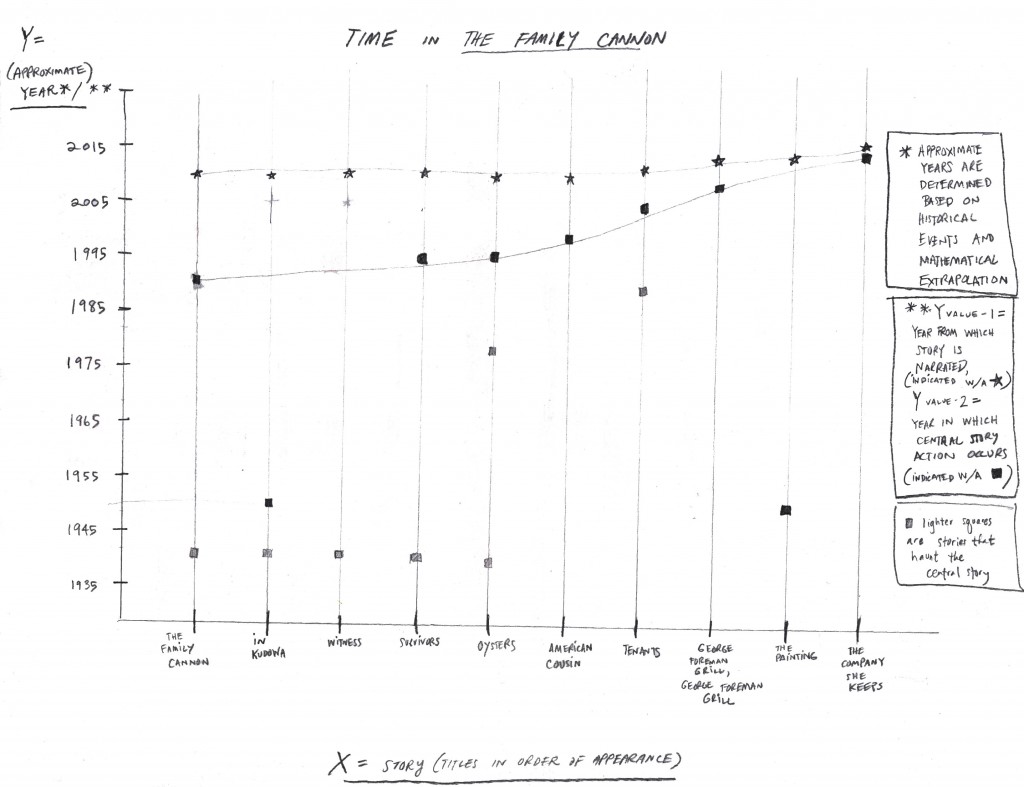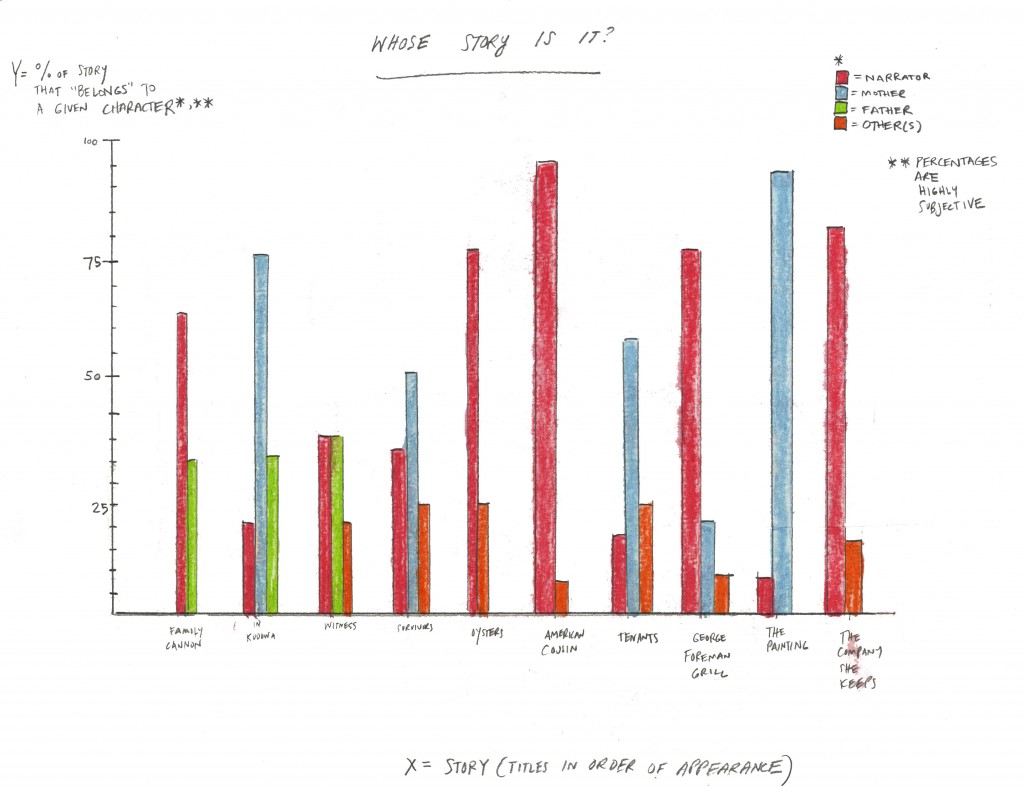SOMEDAY YOU TELL IT TO EVERYONE:
The Family Cannon
A review by Shena McAuliffe
Halina Duraj
Augury Books 2014
113 pages
$15
Collections of linked stories are odd beasts, chimeras that breathe the fire of individual stories while simultaneously galloping over the wide landscape of a novel. Each story has its own brief plot arc or incidents, and (sometimes) resolution, but the stories must also speak to each other. A world forms among them, each story adding to and reinventing the last one. Linked story collections do not, like so many novels, gain momentum from a plot that arcs from beginning to end, but instead from something else, from some other connective strand, be it shared characters, setting, time, form, or narration.
All of the stories in Halina Duraj’s The Family Cannon are narrated by the same woman, the daughter in a family of three, who tells every story, whether or not it is her own. In the title story, she recounts events from her thirteenth year, when her father, a Polish survivor of Auschwitz, provokes a feud with the new neighbor, Mr. Wahler, whom he deems a Nazi for his German name. The final story in the collection is an unflinching recounting of the narrator’s failed courtship—at this point she’s in her thirties. Her engagement, along with some connected friendships, ends in the wake of infidelity. Along that narrative route, from age 13 to age 30, some of the stories she tells “belong” to others—to her mother, for example, or her neighbor—each grown familiar through repeated listening, and, now, repeated telling. But no matter if a story belongs to the narrator or to someone else, it comes to the reader in the observant, patient voice of a single storyteller.
She tells us of her parents’ courtship, and how her father saved a ragged tabby cat from death when she was only two. She tells us of an aging neighbor, less and less able to care for herself, who faces old age alone years after her husband has infamously betrayed her. And through many of the stories winds the thread of that first one: the story of the Auschwitz survivor. These stories are also linked by chronology, ordered from childhood to adulthood (with digressions into her parents’ lives before marriage). On our X-axis we have the titles of the 10 individual stories included in the collection; on our Y-axis we have Approximate Year, which we must chart as at least 2 lines, because many of the stories move between layers of the present and the past. Often the narrator tells the story homodiegetically—as an actor in the story—and from the approximate present point in time. In these stories, we get the narrator’s perspective on events she experienced. In other stories, she speaks from the approximate present, but the present is disrupted by stories of the past. These stories, then, include moments of heterodiegesis—the narrator is not a participant. And these are the stories that require at least two plot points on the axis of time. But even with the double line of time (which is to simplify things), the stories are in roughly chronological order, from around the year 1985 to around the year “now” (see figure 1).
Figure 1: Chronology of The Family Cannon (by story)

On a second graph, our X-axis remains Story Title, but our Y-axis charts the percentage of each story that “belongs” to each character (Narrator, Mother, Father, Others—which includes the cat Rusty, the neighbor, the fiancé, etc.). Because she tells all the stories, the narrator owns a percentage of every story, but she shares every story with at least one other character, reflecting the fact that no story belongs to a single individual (see figure 2).1
Figure 2: Whose Story Is It?

Homodiegetic, heterodiegetic…These are fancy ways of saying that Duraj’s stories are profoundly concerned with the act of telling stories, of remembering them and repeating them. In the title story, the narrator describes how her father, Witek Witecki, survivor of four slave labor camps including Auschwitz, would hold his family and their guests captive with his story, often accompanying words with actions, even belly-crawling across the floor:
My father was especially fond of getting down on the kitchen floor to reenact the entire escape [from Auschwitz to Czechoslovakia]—especially for dinner guests or drop-in visitors. He sprawled on the linoleum beneath invisible tree branches. He always played both parts. He narrated in Polish but shouted and yelled in German. He stomped his feet—SS boots. And then, suddenly, he’d be the trembling boy again, lying under a fir tree. Our guests fidgeted, glanced at the clock; my mother whispered apologies.
This story infects everything in the book, from the father’s relationship with the neighbor to his connection with a fellow Auschwitz survivor he meets at the assisted living home after a stroke takes his speech.
In this story, “Witness,” the narrator, now an adult, visits her father in the assisted living home every day after work. On one of these afternoons she meets Sal Silverstein, who is, like her father, also from Poland, and also, like her father, an Auschwitz survivor. Mr. Silverstein rolls up his sleeve to show the numbers tattooed there. While the narrator’s father suffered in Nazi labor camps, he was not Jewish, and so he was not branded. When the father hears Silverstein’s profession that he is an Auschwitz survivor, he shakes his hand too firmly and his eyes fill with tears. For the father, they are brothers linked by the blood of a shared story. But Silverstein dismisses this emotion: “It is over now. You survived,” he says. “There is always hope. It does no good to cry.” But the narrator’s father continues to cry. Silverstein finally leans back in his chair and points to the number on his arm. “I had it worse than you,” he says. Their stories overlap, but their responses to their experiences differ. Silverstein is not interested in talking about Auschwitz, while the story has woven itself through every element of the father’s life. It haunts his family. But what matters most in “Witness,” is not the omnipresent echo of Auschwitz, but rather how the father’s lost ability to speak has stolen his story. He can no longer tell it, and it is this frustration that rings through “Witness”. The narrator tells the story for him—she speaks it, and now writes it—and in many ways it becomes her story. Like all stories that are told and retold and retold again, the reader learns that the father’s story is full of conflicting details and shades of inaccuracy; it is distorted by time and memory.
But all of this plot summarizing and seeking of themes that overlap between stories, all this thinking about narration, characters, time—none of this gets at what was most striking about Duraj’s book. Sure, these stories are, in part, about storytelling. They are about the ways we are defined by our stories, the ways we use stories to make sense of our lives. And through their linked form these stories reveal the ways that the stories of people in a family, the stories of people in a community, are always linked. The stories of other people intersect with and inform our own stories, which means that storytelling is no small responsibility. But even more, what I noticed about this book was that it struck firm emotional chords. At the end of each story, I had to take a break before moving on to the next—a break from the disappointed desires, the steadfast self-sacrificing mother, the madness and the ghosts, the struggle to remember, to say things just as they should be said. In the end, what is most striking about Duraj’s book is how it moved me; it exhausted me in the way that a good story should.
1 Self-Disclosure: These days, the reviewer works in a graduate student writing center, often helping engineers, medical researchers, and economics scholars edit writing that includes frequent reference to logistic regression, qualitative vs. quantitative methods, tables and figures and charts (Oh, my!). The reviewer admits she is infected by the language and style she encounters in these papers. Graphs and charts, while a potentially useful exercise, do not particularly characterize Duraj’s work, in which the baton of story is passed with remarkable grace, and the narrator moves with fluidity between memory and its telling.
